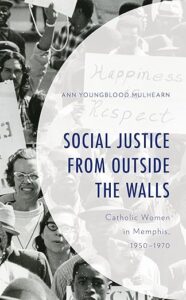Book Review – SOCIAL JUSTICE FROM OUTSIDE THE WALLS by Ann Youngblood Mulhearn
how to join
Resources
about ccwh
We help women historians thrive through events, resources, and community.
Ann Youngblood Mulhearn, Social Justice from Outside the Walls: Catholic Women in Memphis, 1950-1970. Lexington Books, 2024. 234 pp. ISBN: 978-1666922288.
Reviewed by Mary M. Báthory Vidaver, University of Mississippi
 In the various marches that marked the Civil Rights Movement of the 1950s and 1960s, the sight of a priest’s collar or a nun’s habit in a photograph is not surprising because we know the importance of religious groups to the movement. Too frequently, however, we might assume that Catholic participation was white and Northern. In her new monograph, Social Justice from Outside the Walls: Catholic Women in Memphis, 1950-1970, Ann Youngblood Mulhearn demonstrates the flaws in both assumptions. Mulhearn also provides a useful study of intersectionality and how Catholic women in Memphis experienced and linked the upheavals related to civil rights, women’s rights, and the Second Vatican Council.
In the various marches that marked the Civil Rights Movement of the 1950s and 1960s, the sight of a priest’s collar or a nun’s habit in a photograph is not surprising because we know the importance of religious groups to the movement. Too frequently, however, we might assume that Catholic participation was white and Northern. In her new monograph, Social Justice from Outside the Walls: Catholic Women in Memphis, 1950-1970, Ann Youngblood Mulhearn demonstrates the flaws in both assumptions. Mulhearn also provides a useful study of intersectionality and how Catholic women in Memphis experienced and linked the upheavals related to civil rights, women’s rights, and the Second Vatican Council.
Mulhearn anchors her study in the lives of six Memphis women—three Black and three white, born between 1917 and 1929. All three white women and one African American woman were ‘cradle Catholics,’ born into the church, while the other two were adult converts. All of the women were college-educated and worked before they married. One woman took religious vows; the others raised children, though several worked concurrently by choice rather than need. All were firmly ensconced in the middle class. Tracing their lives, Mulhearn demonstrates the breadth of Black and white Catholicism in terms of numbers and institutions across the region.
Mulhearn also explores the women’s spiritual journeys as they negotiated the cognitive gap created by the Catholic Church’s stated belief in racial equality versus the harsh reality of life in the South, particularly within the circumscribed role of Catholic womanhood. This involves a deep dive into the theological currents of interwar and post-war Catholicism in which these women came of age, as well as during the era of Vatican II. She does this in a way that is both doctrinally precise and accessible to non-Catholics. Interestingly, a key influence on four of the women was Dorothy Day and her Catholic Worker Movement. Two of the women worked directly with Day’s organization, leading to the brief existence of a Memphis home styled on the Catholic Worker house in New York.
What emerges from these profiles placed in their historical and theological context is an understanding of the double set of fences faced by white Catholic women, the triple set faced by African American women, and the spiritual commitment required to hold a mirror of faith up to white Christians—Catholics and Protestants—in Memphis. None of these women and their allies emerged unscathed. One left Memphis for California, another, one of the most visible and mystically inclined, ultimately joined her husband’s Presbyterian church. Yet, they persisted in integrating the state’s Catholic schools and forging a “municipal housekeeping” public role for Catholic women. They welcomed and marched with Martin Luther King, Jr. before his death and played an instrumental role in the sanitation workers’ union’s meaningful victory the following year.
Overall, this book contributes to a growing body of work on Southern Catholics—both Black and white—and the role of women in the region’s social movements. However, there were a couple of places where I wish Mulhearn had dived a bit deeper into her historiography. First, her reliance on a text from 1964 extends a narrative of Southern Catholic marginalization, which is currently under challenge by scholars such as Andrew H. M. Stern and James M. Woods. In their narratives, the experience of Southern Catholics before and after the Civil War looked very different from the Catholic experience in Boston or New York City. My own dissertation research concurs that until the Americanism movements of the 1920s, whiteness counted more than religion, a priority resumed by the white Protestant majority in the face of the Civil Rights Movement. Secondly, Mulhearn gives no cognizance to parallel strands of theology within Protestantism during this period, concluding that Catholic women preceded Protestant women in their racial justice activism. For white Protestants, there may be some truth to this claim for white women. However, I would also point to the various iterations of social Christianity permeating the Young Women’s Christian Association throughout the 20th century.
These gaps notwithstanding, Mulhearn’s book provides a fine, well-written account that should encourage further work on the impact of race, religion, and gender at the local level within larger social movements. These six women had numerous peers across the region, particularly in the Catholic strongholds of Kentucky, Louisiana, South Carolina, and Virginia. In Richmond, the former capital of the Confederacy, Catholic women’s church groups were among the earliest organized challengers to Massive Resistance—the Byrd Organization’s strategy to prevent public school integration—a hidden narrative that bears resurrection. This book provides a framework for that future scholarship.
September 20, 2025
how to join
Resources
about ccwh
We help women historians thrive through events, resources, and community.
Copyright © 2022 Coordinating Council for Women in History. All Rights Reserved.
Privacy Policy | Terms of Use | site credit